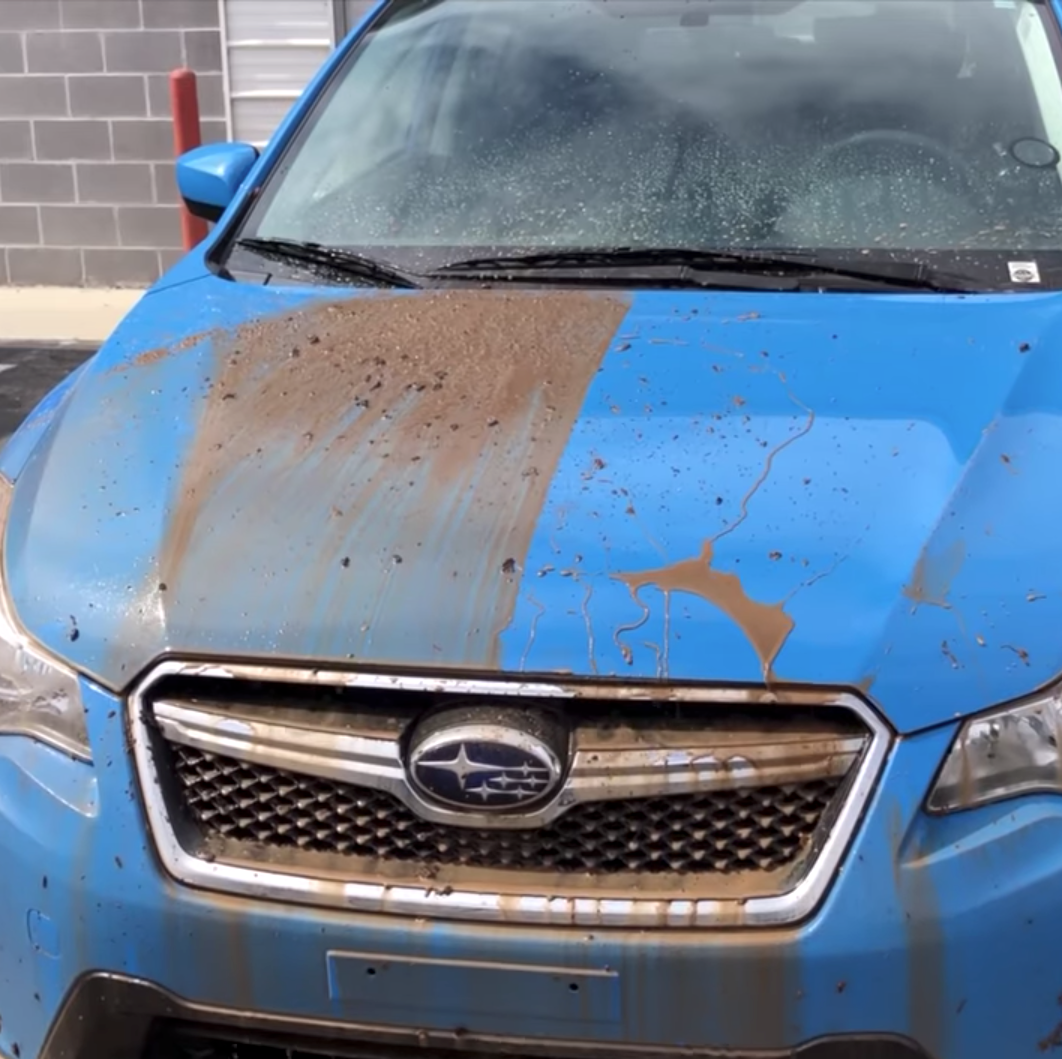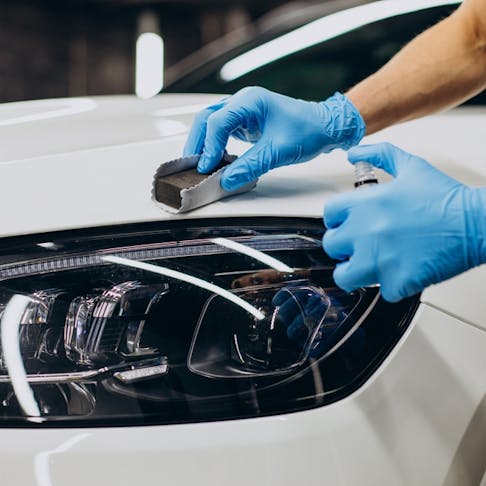Exploring the Science Behind Car Ceramic Coating and Its Protective Characteristics
The science of car ceramic coating provides a fascinating study in sophisticated vehicle defense. Composed primarily of silicon dioxide and polymers, these finishings develop a robust bond with car paint. This interaction enhances durability against environmental dangers while providing hydrophobic advantages. The ins and outs of how these finishes job and their lasting benefits stay much less comprehended. Ceramic Coating Newark. Unboxing these details reveals why ceramic coverings are ending up being a preferred choice for car treatment
What Is Ceramic Coating?
Ceramic coating is a fluid polymer that chemically bonds to the surface area of a lorry's paint. This innovative protective layer boosts sturdiness and provides premium resistance to ecological factors. Unlike standard wax or sealers, which offer temporary defense, ceramic coatings produce a durable guard that can stand up to rough problems such as UV rays, acidic impurities, and extreme weather. When used properly, the coating develops a hydrophobic surface, creating water to bead and slide off, which helps in keeping the vehicle's cleanliness. Furthermore, it offers boosted gloss and depth to the paint, making the vehicle show up more refined and lively. The application process commonly includes thorough surface area prep work, consisting of cleaning and sprucing up, to guarantee peak bonding. Consequently, ceramic coatings are becoming increasingly prominent among car fanatics and those looking for to safeguard their investments, assuring to maintain the vehicle's aesthetic charm while reducing the regularity of upkeep.
The Composition of Ceramic Coatings
The detailed formulation of ceramic finishes largely includes silicon dioxide (SiO2), which is stemmed from all-natural sources like quartz and sand. This essential component offers the structure for the coating's toughness and protective high qualities. Along with SiO2, ceramic finishes typically include various polymers and additives that enhance bond, versatility, and resistance to environmental factors. These substances function synergistically to create a robust barrier versus pollutants such as dust, chemicals, and UV rays.Furthermore, some formulas integrate titanium dioxide (TiO2) or other nanomaterials, which can increase the coating's hydrophobic properties, causing improved water repellency. The precise make-up can differ greatly among manufacturers, impacting performance and durability. Ultimately, the mix of these elements culminates in a safety layer that not just improves the aesthetic appeal of vehicles yet also serves to lengthen their life expectancy by shielding the surface from possible damages.
How Ceramic Coatings Work
Understanding just how ceramic finishings work involves exploring their chemical composition, which adds to their protective high qualities. The application process is crucial for attaining suitable results, while longevity and longevity aspects determine the coating's efficiency in time. Together, these components highlight the advantages and performance of ceramic coatings for vehicle protection.
Chemical Structure Explained
While lots of car proprietors seek lasting protection for their automobiles, the chemical structure of ceramic coverings plays a vital role in their effectiveness. These layers mostly contain silicon dioxide (SiO2), which is derived from all-natural minerals. This compound creates a strong bond with the vehicle's paint, producing a resilient, safety layer. Additionally, numerous ceramic layers include titanium dioxide (TiO2), enhancing their hydrophobic homes and resistance to UV rays. The visibility of polysiloxanes can even more enhance versatility and resilience. With each other, these components add to the coating's capability to fend off water, dust, and impurities, while additionally providing a high-gloss coating. Comprehending this chemical foundation assists car proprietors appreciate the durable protection provided by ceramic coverings.
Application Process Review
Using ceramic finishes involves a careful procedure that assures perfect bonding and protection for the lorry's surface. At first, complete cleaning and purification of the car's exterior are carried out to get rid of dirt, crud, and previous waxes. This step confirms that the surface area is without impurities that can prevent bond. Following this, the paint is frequently polished to enhance clearness and remove any type of imperfections. Once prepared, the ceramic coating is used in tiny areas using an applicator pad, enabling consistent coverage. The coating is after that entrusted to treat, creating a solid chemical bond with the surface area. Proper healing times and problems are critical, as they confirm the coating attains its optimum performance and protective qualities.
Long Life and Longevity Variables
Ceramic coatings are created to give long-lasting security via their innovative chemical make-up, which produces a durable barrier against environmental pollutants. The durability of these coverings is influenced by factors such as the density of the application, the quality of the item, and the problems under which the lorry is subjected. High-grade ceramic layers can last a number of years, standing up to scrapes, UV rays, and chemical stains. Correct upkeep, including regular cleaning and routine reapplication, can further improve longevity. In addition, ecological elements like climate and exposure to pollutants can impact the lifespan of the coating. In general, when used and preserved properly, ceramic coatings supply outstanding durability, making them a prominent choice for car enthusiasts seeking to maintain their automobile's appearance.
Hydrophobic Residences and Water Repellency
Hydrophobic properties are a hallmark of high quality car ceramic coatings, significantly enhancing the automobile's surface performance. These layers develop a molecular bond with the car's paint, causing a surface that pushes back water properly. When water enters call with a ceramic-coated surface, it grains up and rolls off, lessening the quantity of liquid that remains on the paint. This habits not only adds to visit their website an aesthetically pleasing look yet also decreases the accumulation of impurities such as dust, gunk, and roadway salts.The enhanced water repellency leads to easier cleaning and upkeep, as less effort is called for to get rid of undesirable compounds. Additionally, the hydrophobic nature of ceramic finishes assists in protecting against water areas, which can mar the surface of uncoated surfaces. Overall, the incorporation of hydrophobic buildings in ceramic coatings plays an important function in preserving the vehicle's excellent appearance while simplifying upkeep.
Defense Against Scratches and UV Damage
Car ceramic finishings use considerable security against scrapes and UV damages. The scratch resistance mechanism produces a sturdy layer that soaks up effects, while the UV protecting advantages aid keep the car's paint stability over time. With each other, these attributes add to a longer-lasting and visually enticing finish.
Scratch Resistance Device
Making use of innovative technology, ceramic layers offer a robust guard against scratches and UV damage, improving the longevity and look of automobile surface areas. The scratch resistance device of these finishings is associated to their one-of-a-kind molecular framework, which creates a durable bond with the vehicle's paint. This bond produces a hard, safety layer that can take in impacts and withstand abrasions. Additionally, the smooth surface of the coating reduces rubbing, making it difficult for contaminants to adhere and trigger scratches. The chemical composition of ceramic finishings commonly includes nanoparticles that reinforce the protective layer, additional boosting its resilience. Cars treated with ceramic finishings display markedly improved scrape resistance contrasted to conventional wax or sealants, ensuring an immaculate surface over time.
UV Shielding Perks
The protective top qualities of ceramic coverings prolong past scratch resistance to include considerable UV securing advantages. These finishings develop a robust obstacle that mirrors damaging ultraviolet rays, protecting the vehicle's paint and underlying products. Extended direct exposure to UV radiation can cause fading, oxidation, and damage of the paint finish. By including ceramic layers, car owners can efficiently reduce these threats, preserving the visual charm and honesty of their autos. Additionally, the UV obstructing residential or commercial properties contribute to boosted durability, minimizing the frequency of painting and maintenance. Inevitably, the combination of ceramic coverings supplies a complete remedy for shielding vehicles from the damaging impacts of sunlight direct exposure, ensuring a sustained, vivid look in time.
The Durability and Upkeep of Ceramic Coatings

Often Asked Questions
Can Ceramic Coating Be Applied to Any Type Of Kind of Car?
Ceramic coating can be put on different kinds of cars, including autos, trucks, and bikes. However, surface area prep work and compatibility with details materials are necessary for excellent attachment and efficiency of the coating.
Just How Much Does Ceramic Coating Normally Cost?
Ceramic coating generally sets you back between $500 and $2,000, depending upon aspects such as vehicle dimension, coating high quality, and professional application. The financial investment that site can supply durable defense and boost the vehicle's appearance over time.

Is Specialist Application Necessary for Best Outcomes?
The need of specialist application frequently depends upon preferred outcomes. Professionals typically guarantee correct surface area preparation and application strategies, resulting in excellent bonding and longevity of the coating, which may be challenging for inexperienced individuals to accomplish.
Can Ceramic Coatings Be Eliminated or Repaired?
Ceramic coverings can be eliminated or fixed, though the procedure may require certain solvents or methods - Ceramic Coating Newark. Correct elimination is vital to avoid damages read more to the underlying surface, stressing the value of professional support for suitable outcomes
Just How Does Porcelain Coating Contrast to Standard Wax?
The contrast between ceramic coating and standard wax discloses that ceramic layers use superior durability, improved defense versus ecological impurities, and longer-lasting shine, while wax calls for more constant application and provides much less total resistance to damages.